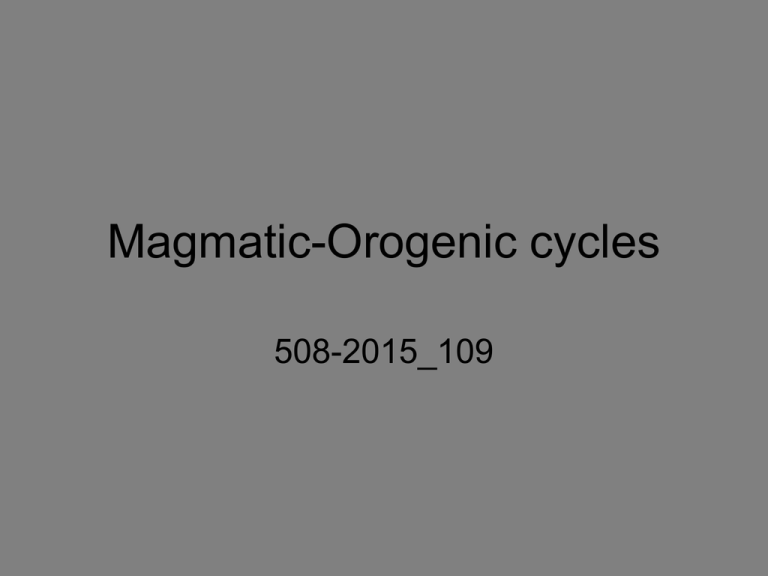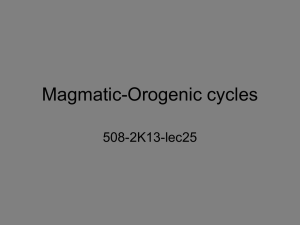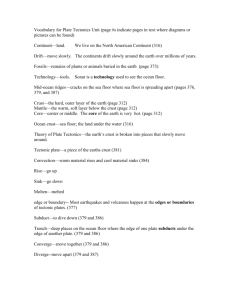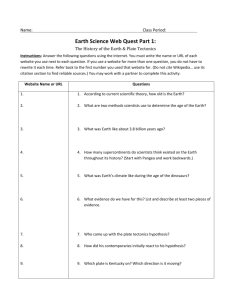508_2K15_109
advertisement

Magmatic-Orogenic cycles 508-2015_109 N. American Cordillera scale • • • • • No depth bias; Mostly upper plate-derived magmas; Significant pre-existing crust involved; Flare-ups are compressional; Fluxes vary by a factor of 10. Regional age-depth 12 10 Depth (km) 8 6 4 2 0 0 50 100 150 200 250 Age (Ma) 300 350 400 450 Quartz delta 18O- all N. American Cordilera- Average quartz ~ 9.4 ‰ SMOW Nd isotopes in Cordilleran batholiths Average North American Cordillera nd(i)= -4.5 Predominant input of North American lithosphere Magmatic fluxes • Average (Reymer and Schubert, 1984) – 20-40 km3/kmMa • Lulls and flare-ups. – Need detailed info on individual pluton surface area, depth of emplacement and age. Lots of data everywhere, very little synthesis work has been done. Enough data for Sierra, Coastal batholith of Peru, maybe a couple more worldwide; – 10-25 km3/kmMa, baseline – Up to 500 km3/kmMa flare-ups Barton et al., 1988 Barton, 1996 Idaho Batholith - Strontium IDB - Age vs. Sr(i) 0.74 Sr(i) 0.73 Idaho 0.72 Montana 0.71 0.7 0 20 40 60 80 100 Age (Ma) 120 140 160 180 N Peninsular Ranges Batholith (K only) 0 65 75 85 95 -5 eNd(t) -10 -15 -20 -25 Age (Ma) 105 115 125 Epsilon Nd vs time California arc Coast Mountains - Including Alaska Flare-ups are marked by increased N-American input- these are compressional arcs. What drives high flux events? plate kinematics upper plate deformation Other? Plate kinematics and fluxes • Data available only for magmatic arcs – Early work on the Coast Mountains batholith (Armstrong, 1988) proposed they may be correlated: faster convergence higher fluxes. California arc - no correlation (see next slide). Apparent intrusive flux vs. time and plate motions Ducea, 2001 Magmatic flare-ups • Short, high flux events separated by lulls • Baseline fluxes coincide with steady state island arcs (10-30 km3/km Ma). Flare-ups generate 10 times more magma within short (5-15 My) periods. Most of the continental arcs are made in flare-ups. • Don’t know what ignites the high flux events – We do know they are compressional events. Some Relevant Facts: Shortening in some thrust belts amounts to 300-700 km (Andes, North American Cordillera, Himalaya) Rocks involved are almost exclusively upper crustal Requires disposal of large volumes of continental lower crust and lithosphere beneath orogenic belts Some Questions: What are the spatial-temporal relationships between shortening, magmatism, and mantle processes? Can we track these through time? How much continental crust is involved and where does it go? Implications for mantle chemistry and Earth evolution? The concept of a tectono-magmatic cycle in major orogenic belts, with emphasis on subduction of continental crust and lithosphere on the foreland side: Cordilleran but can be extended to collisional Age of ductile thrusting predates flare-ups by some 15-35 my DeCelles, Ducea, Zandt,Kapp 2009 What is not in the model • Forearc and trench contributions, known to be a factor, in some arcs • Possible storage and release mechanisms in the lower crust • Need better constraints on plate kinematics to fully rule those effects out. •>65% of the volume of magmatic rocks in the coastal batholiths of North America are formed in short, 5-15 My flare-up (hih flux) events; •These episodes are dominated by upper plate mass, mantle and crust; •They are not demonstrably related to plate kinematic parameters in the few areas where enough data is available; •Oxygen isotopes are clearly showing tens of % of mass is recycled crustal; •One mechanism suggested here is retroarc thickening. It reconciles geologic constraints.









